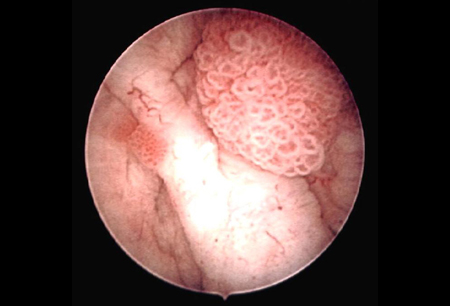This type of cancer can generally be broken down into two categories. The precise nature of precursor lesions of bladder cancer remains incompletely understood.
Squamous cell carcinoma is most often found in parts of the world where a parasitic infection called schistosomiasis is widespread such as the Middle East.

Flat bladder cancer. In the 1998 World Health Organization and International Society of Urologic Pathology WHOISUP classification system for bladder neoplasms flat intraepithelial lesions of the urinary bladder were categorized as reactive atypia atypia of unknown significance dysplasia and carcinoma in situ. Papillary carcinomas grow in slender finger-like projections from the inner surface of the bladder toward the hollow center. If a flat tumor is only in the inner layer of bladder cells it is referred to as a non-invasive flat carcinoma or a flat carcinoma in situ.
Flat bladder tumors also called sessile do not grow into the hollow part of bladder but grows in a flat shape instead. If either a papillary or flat carcinoma grows into the deeper layers of the bladder it is called an invasive urothelial carcinoma. Squamous cells look similar to the flat cells on the surface of.
It can also be referred to as Non-Muscle Invasive Bladder Cancer or NMIBC. Rarer types include squamous cell bladder cancer adenocarcinoma sarcoma and small cell bladder cancer. CIS is a type of nonmuscle-invasive bladder cancer that is of higher grade and increases the risk of recurrence and progression.
Doctors also describe your bladder cancer based on how far it has spread into the bladder wall. The worldwide age standardised The worldwide age standardised incidence rate ASR is. Bladder carcinoma is the most common malignancy of the urinary tract.
Most bladder cancers present as superficial disease confined to the bladder mucosa or submucosal layer without muscle invasion. The worldwide age-standardised incidence rate per 100000 personyears is 95 for men and 24 for women 10. This is also called urothelial bladder cancer.
Bladder CIS presents itself as a flat rash- or moss-like growth on the bladder lining. Flat cancer Bladder cancers are also divided into 2 subtypes papillary and flat based on how they grow see the image above. These tumors are.
They have not spread invaded into the muscle layer. Urothelial carcinoma also known as transitional cell carcinoma is a type of bladder cancer that starts in the surface of the bladders lining. One type of slow growing non-invasive papillary bladder cancer is called papillary urothelial neoplasm of low malignant potential PUNLMP.
Squamous cell carcinoma accounts for about 1 percent to 2 percent of bladder cancers diagnosed in the United States. If a flat carcinoma is confined to the urothelium it is called noninvasive flat carcinoma or flat carcinoma in situ. In some cases it may not be visible upon examination and only shows up.
Flat bladder lesions comprise a spectrum of morphologic changes ranging from reactive atypia to carcinoma in situ CIS. Bladder carcinoma in situ abbreviated CIS is always high grade and requires immediate treatment. Staging is a careful attempt to find out whether the cancer has invaded the bladder wall whether the disease has spread and if so to what parts of the body.
Grade refers to what the cancer cells look like and how many cells are multiplying. Rarer forms of bladder cancer include. Papillary tumors often grow toward the center of the bladder without growing into the deeper bladder layers.
It can also be flat and red which is called carcinoma in situ CIS. Rather flat carcinomas remain on the surface of the bladder wall. If bladder cancer is diagnosed the doctor needs to know the stage or extent of the disease to plan the best treatment.
Bladder cancer BC is the seventh most commonly diagnosed cancer in the male population worldwide while it drops to tenth when both genders are considered 10. This is when the cancer cells are only in the inner lining of the bladder. Carcinoma in situ CIS is a cancerous patch of bladder lining often referred to as a flat tumor The patch may look almost normal or may look red and inflamed.
The clinical outcomes of patients diagnosed with these atypical urothelial proliferations are. This cancer begins in the thin flat squamous cells that may form in the bladder after chronic inflammation and infection. The most common type of bladder cancer is transitional cell bladder cancer.
Urothelial CIS is the most definitely characterized precursor lesion. Flat carcinomas do not grow toward the hollow part of the bladder. Superficial tumors consist of papillary tumors that are mucosally confined Ta papillary or sessile tumors extending into the lamina propria T1 and carcinoma in situ which occurs as flat mucosal dysplasia which can be focal diffuse or associated with a.
You can have either non muscle invasive early or superficial bladder cancer or invasive. Some people may have both papillary cancer and CIS. Non-muscle-invasive bladder cancer can be mushroom shaped which is called a papillary tumour Ta.
Differentiating these lesions is important because of differences in patient management and clinical outcome.

Recent Technological Advances In Cystoscopy For The Detection Of Bladder Cancer Sciencedirect

Recent Technological Advances In Cystoscopy For The Detection Of Bladder Cancer Sciencedirect

Carcinoma In Situ Lesion Missed During Standard Cystoscopy And Only Download Scientific Diagram

Bladder Cancer Treatment Pdq Pdq Cancer Information Summaries Ncbi Bookshelf

What Is Bladder Cancer Bc Care

Diagnostics Free Full Text A Potential Application Of Dynamic Contrast Enhanced Magnetic Resonance Imaging Combined With Photodynamic Diagnosis For The Detection Of Bladder Carcinoma In Situ Toward The Future Mri Pdd Fusion Turbt

Hypervascularity And Hyperproliferation Of The Bladder Carcinoma In Download Scientific Diagram

Pin On Healthy Living And Fitness

Carcinoma In Situ Lesion Missed During Standard Cystoscopy And Only Download Scientific Diagram

Bladder Cancer Treatment Pdq Pdq Cancer Information Summaries Ncbi Bookshelf

Photodynamic Diagnosis And Therapy For Urothelial Carcinoma And Prostate Cancer New Imaging Technology And Therapy Springerlink

Bladder Cancer Symptoms Diagnosis And Treatment Bmj Best Practice Us









